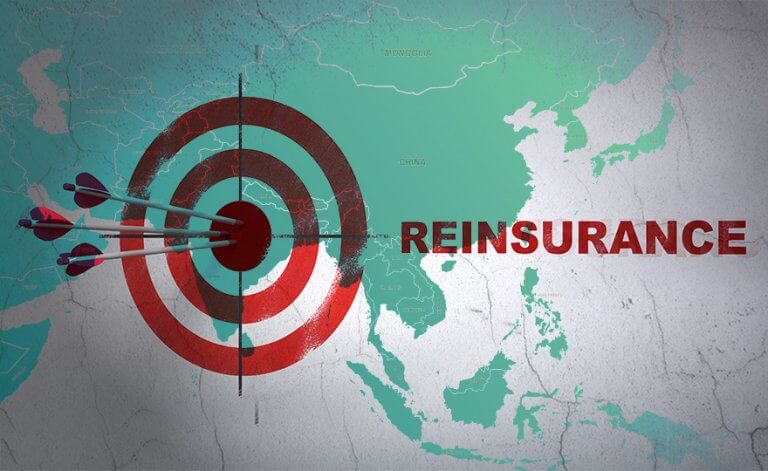South-East Asia’s reinsurers face underwriting challenge
September 1 2021 by Andrew Tjaardstra
Reinsurance firms operating in South-East Asia are increasingly focusing on underwriting profitability as they come to terms with a low interest rate environment and stronger competition.
“In the first half of 2021, South-East Asia’s reinsurers exhibited moderate improvements in underwriting performance due to rate corrections observed notably in property treaty 2021 renewals and a decline in travel, motor and workers’ compensation claims driven by Covid-19 restrictions,” Kanika Thukral, a senior financial analyst at AM Best, told InsuranceAsia News (IAN).
According to Willis Re’s January 2021 renewal report, Asian reinsurance buyers overall saw flat to low single digit rate increases for loss-free renewals in property, while loss hit accounts saw rate increases between 5-10%.
However, Singapore-based Thukral said that pricing increases “remain insufficient for South-East Asia reinsurers to achieve notable improvements” Thukral added that “further rate corrections and ongoing underwriting discipline” are required for reinsurers to “achieve sustainable operating performance metrics that meet the cost of capital over the medium term.”
The region’s reinsurers were hit by Covid-19 driven investment shocks in 2020 and an expectation of suppressed interest rates over the medium term, according to an August 31 AM Best report. As a result, reinsurers have been recalibrating underwriting strategies, improving expense management, rebalancing portfolios and trying to better manage their exposure to natural catastrophes.
In addition, reinsurers’ combined ratios have been above 100% for the last five years (2016-20) and the rating agency expects the market to face headwinds from a combination of strong competition, rate pressure, excess capacity and high nat cat activity. While international reinsurers have boosted regional capacity, especially for property, engineering and marine risks, they have added to rate pressures leading to some underperformance, the report noted.
On the other hand, South-East Asia’s reinsurers benefitted from a negligible impact of business interruption claims associated with Covid-19 due to infectious disease and business interruption exclusions brought in following the 2003 SARS outbreak.
Nat cat exposure
The growth of South-East Asia’s nat cat exposure is also helping drive reinsurance demand and shows the potential for top line growth.
The Swiss Re Institute’s nat cat resilience index has said that emerging Asia-Pacific is the least resilient region — with over 96% of nat cat losses not insured. In Indonesia, India and the Philippines, only 5-7% of physical assets are estimated to be insured against major perils.
And underwriting performance in this area also improved last year. After some large cat losses in 2018/19, mainly in Japan, reinsurers’ 2020 loss experience was moderate — with only a few major storms in the Philippines, Vietnam and Korea, AM Best noted. However, 2021 has already seen an earthquake in Fukushima that is estimated to have exceeded US$2 billion in insured losses.
Reinsurers will be hoping for a calm second half to the year in the region but life and health players are already bracing for some large payouts as the full impact of Covid-19 plays out across South-East Asia.
-
1.1 renewals steady despite delays as excess capacity drives softer pricing across APAC
- December 22
Reinsurers and brokers report competitive pricing, stable terms, and selective loss impacts, with abundant capacity reshaping negotiations and, in some cases, cedents pushing for up to 20% rate reductions.
-
AI can offset carbon risk gaps for insurers, with APAC at the forefront
- December 19
Carbon offset platform market industry value has been put at US$190.7bn, but that figure is forecast to grow to US$1.6trn in the next decade.
-
Rise of zombie companies, supply chain nerves propel demand for trade credit insurance
- December 18
Asia is set to be the largest contributor to insolvency increases accounting for half of the global rise in 2025, Allianz Trade’s Hassan Omaish says.
-
‘Humming’ India to be priority for insurers in 2026 amid market reforms, GDP growth
- December 16
Move to allow 100% foreign ownership of insurance companies, and rapid economic growth, will drive a wave of dealmaking.
-
QBE | Elevating customer experience, humanising claims: QBE Asia’s ‘Solutions in a Box’
Vastly improving turnaround times and personalising service delivery, QBE Asia’s award-winning, end-to-end bundled claims solutions is a game-changer for the insurance industry.
-
Beazley | What does cyber protection look like from day 1 to day 600 and beyond?
Cybersecurity is no longer just an IT concern, but a governance issue that belongs on the boardroom agenda.
-
Sedgwick | Preparing for the next storm
Insurance industry needs to recalibrate, invest in innovation and strengthen systems, talent and data practices.
-
Peak Re | From climate modelling to market opportunity: Forging a new clarity on Southeast Asia’s climate risk
Southeast Asia's protection gap: a crisis of clarity, not just capital

